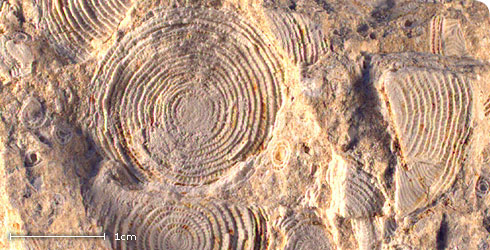Distribution
The genus Nummulites ranged through time from late in the Middle Palaeocene epoch (about 60 million years ago [Ma]) to near the end of the Oligocene epoch (around 25Ma), with the species N. gizehensis living during the Middle Eocene epoch (48Ma - 37Ma).
The stratigraphical value of Nummulites was first recognised in the mid-nineteenth century, when studies were made of collections of fossils from southern France, Switzerland, Egypt, Libya and India - geographical areas once occupied by the warm tropical waters of an ancient sea called Tethys.
They lived in shallow reef environments, where they often thrived to rock-forming abundance, producing porous carbonate rocks such as the limestone illustrated. While this in itself is quite incredible, an oil man once noted that they are even more interesting when the myiad tiny chambers, once occupied by the animals, are found now to be filled with crude oil.
The specimens illustrated are from Egypt, occurring in a distinct rock unit called the Mokattam Limestone. They come from an old quarry close to Cairo (hence the name), which once supplied the huge blocks of limestone used in the construction of the ancient pyramids. Small examples of these fossils, when found whole, resemble lentils and were once thought to actually be fossilised lentils as eaten by ancient Egyptians. These specimens have been split open naturally by the break in the host rock to reveal their internal structure.
Population biology
Was extremely abundant, being found in rock-forming quantities.
